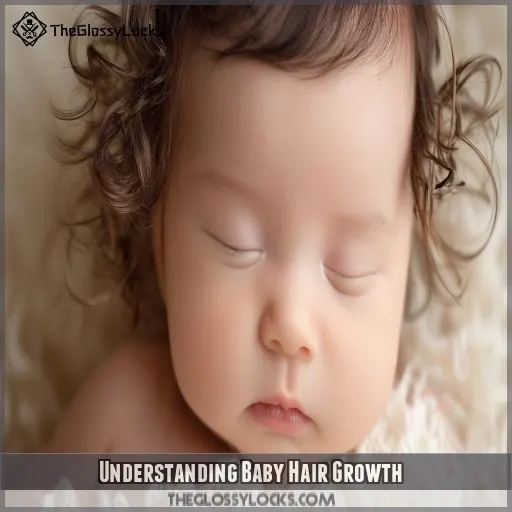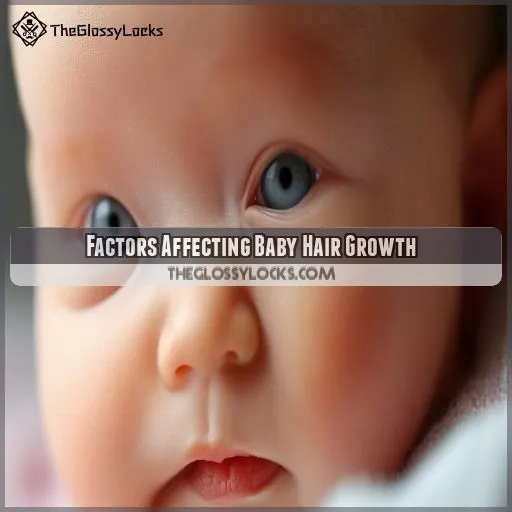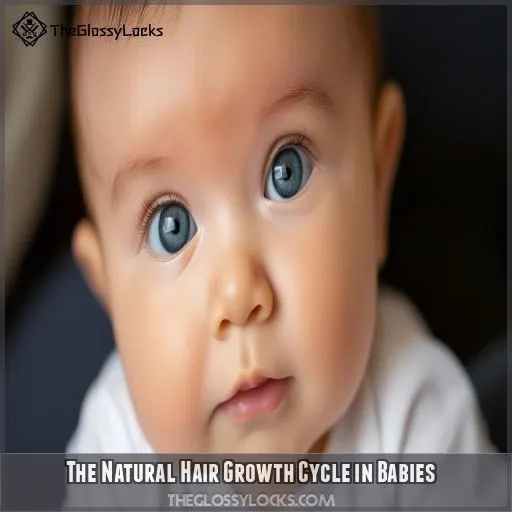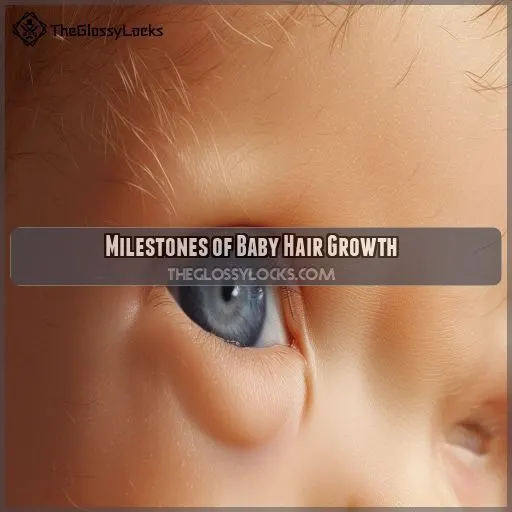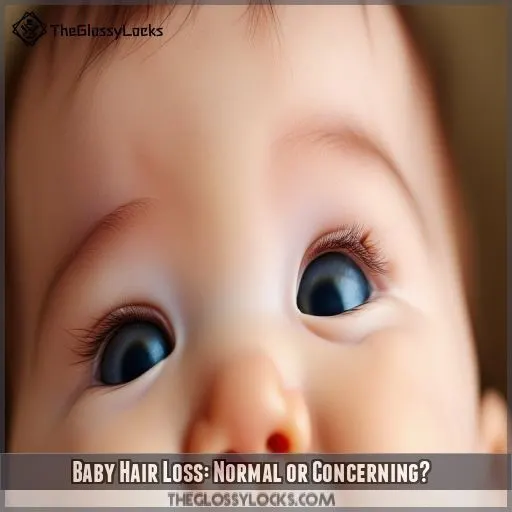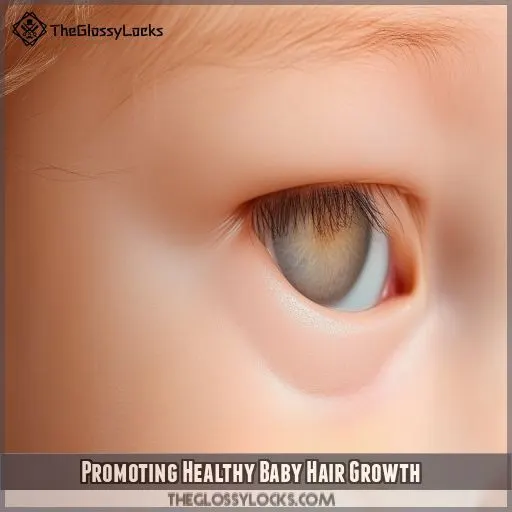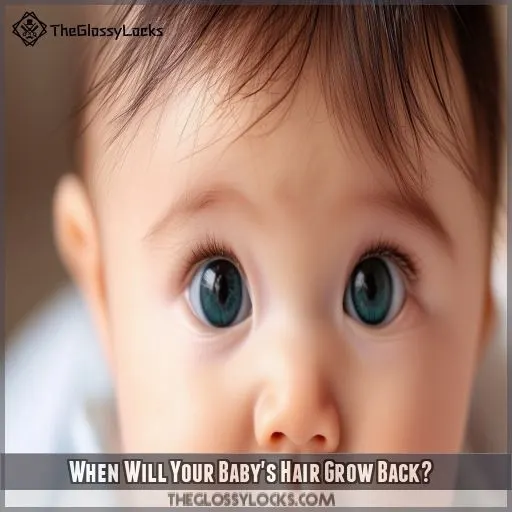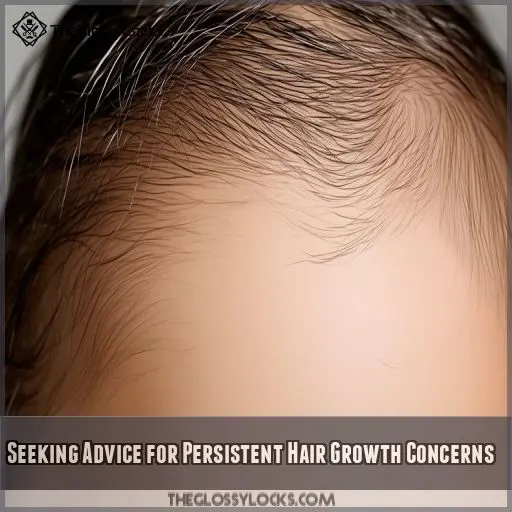This site is supported by our readers. We may earn a commission, at no cost to you, if you purchase through links.
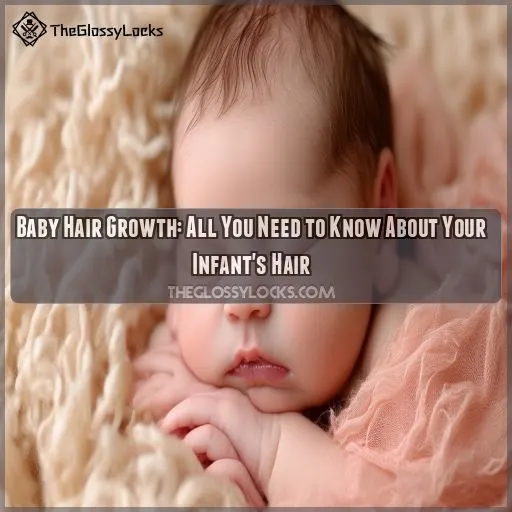
Your baby’s hair will usually grow between the ages of 6 and 12 months, but this varies.
Table Of Contents
- Key Takeaways
- When Baby Hair Growth?
- Understanding Baby Hair Growth
- Factors Affecting Baby Hair Growth
- The Natural Hair Growth Cycle in Babies
- Milestones of Baby Hair Growth
- Baby Hair Loss: Normal or Concerning?
- Promoting Healthy Baby Hair Growth
- When Will Your Baby’s Hair Grow Back?
- Seeking Advice for Persistent Hair Growth Concerns
- Frequently Asked Questions (FAQs)
- When does baby hair grow?
- Why does hair fall happen at a young age?
- What happens when a baby starts a new hair growth cycle?
- Do babies have hair growth patterns?
- At what age do babies get real hair?
- At what month does baby hair grow?
- When can you tell if your baby will have hair?
- Why does my 6 month old have no hair?
- What foods promote hair growth?
- How often should I shampoo my babys hair?
- How can I tell if my babys hair loss is normal?
- What hair products are safe for babies?
- How can I protect my babys hair from sun damage?
- Conclusion
Key Takeaways
- Baby hair growth varies, but it typically occurs between 6 and 18 months.
- It’s normal for babies to be born with a full head of hair or none at all, and their hair color and texture can change as they grow.
- Hormonal changes, genetics, and physical factors like cradle cap influence a baby’s hair growth and thickness.
- You can promote healthy baby hair growth with a nutritious diet, gentle hair care practices, and protection from the elements.
When Baby Hair Growth?
The growth of your baby’s hair is influenced by a combination of genetics and hormones, resulting in unique hair colours and textures.
Postpartum, hormonal changes can cause hair loss in mothers, which also affects newborns.
Cradle cap and friction are additional factors that influence hair growth patterns.
Within the first six months, you can expect hair loss and regrowth, with hair gaining strength and texture between seven and nine months.
By one to two years, terminal hairs develop, giving your baby’s hair a fuller appearance.
If you’re curious about the specifics of baby hair growth milestones and potential concerns, keep exploring.
Understanding Baby Hair Growth
Baby hair growth is a fascinating process, and it’s normal to wonder about your little one’s hair texture, scalp health, and overall hair care.
From birth, babies have hair follicles, and some are born with a full head of hair, while others are bald.
Don’t worry if your newborn experiences hair loss in the first six months; it’s common due to hormone changes.
Cradle cap, a condition causing flaky skin on the scalp, can also lead to temporary hair loss.
Luckily, it usually clears up on its own, but gentle shampooing can help.
As your baby grows, their hair will go through changes in texture and colour, finding its unique style.
Factors Affecting Baby Hair Growth
There are a few factors that affect your baby’s hair growth, including genetics, hormones, and physical factors. For example, the amount of hair your baby is born with is influenced by their genetics and hormone levels, and physical factors like friction from sleeping on their back or cradle cap can also contribute to infant hair loss.
Genetics and Hormones
Your baby’s hair color and texture are influenced by genetics and hormones.
It’s all about those chromosomes!
Your baby’s hair color may change as they grow, but it’ll eventually settle on a permanent shade by around age five.
Hormonal Changes
Hormones play a huge role in your baby’s hair growth journey.
A drop in hormones after birth can lead to initial hair loss, but don’t worry, it’s normal and temporary.
These hormonal shifts also influence hair thickness and follicle development, determining whether your baby’s hair will be thick or thin.
And it’s not just babies; postpartum hair loss in moms is also linked to these hormonal changes.
Physical Factors
Here are some physical factors that can influence your baby’s hair growth:
- Hair thickness and density: Some babies are born with thick, dense hair, while others have thin, fine hair. Thicker hair may be more prone to breakage and shedding, while finer hair may appear less noticeable.
- Scalp sensitivity: Your baby’s scalp sensitivity can impact hair growth. Cradle cap, a common condition causing flaky skin on the scalp, can lead to hair loss if left untreated.
- Cradle cap severity: Cradle cap can vary in severity, ranging from mild flaking to more extensive scaling. More severe cases may require medical treatment to prevent hair loss.
- Friction from sleeping: Sleeping on the back can create friction, leading to hair loss, especially if your baby has a sensitive scalp.
- Genetic predisposition: Your baby’s hair growth may also be influenced by genetics, including the thickness, density, and texture of their hair.
The Natural Hair Growth Cycle in Babies
The natural hair growth cycle in babies has distinct stages, and it’s normal for your baby’s hair to change.
Some babies are born with a full head of hair, while others are bald.
During the first six months, their hair may thin or fall out due to hormone changes.
From three to six months, it often grows back thicker.
From seven to nine months, hair gains strength and texture.
By 10–12 months, it becomes coarser, and cradle cap disappears.
This cycle is a natural part of your baby’s development, so embrace the changes and enjoy their evolving look!
Milestones of Baby Hair Growth
Your baby’s hair will go through several milestones in their first year. From birth to 6 months, they may be bald or have fine, silky hair. Then, from 6 to 12 months, their hair often starts to come in thicker and coarser.
Newborn Hair Characteristics
Your newborn’s hair characteristics can vary, and there are numerous aspects to contemplate, including hair follicle development, hair shaft structure, and scalp sensitivity. Here are some key points to keep in mind:
- Hair Follicle Development: All newborns have hair follicles, but the quantity and thickness of hair can differ. Some babies are born with a full head of hair, while others have sparse or no hair.
- Hair Shaft Structure: Newborn hair tends to be fine and silky, with short, thin strands known as vellus hair.
- Scalp Sensitivity: Newborn scalps are delicate, so gentle care is essential. Conditions like cradle cap can cause temporary hair loss, so it’s crucial to monitor your baby’s scalp health.
Hair Growth Stages
Your baby’s hair growth journey is an exciting process with several milestones. Here’s what you can expect:
- Newborn: Your baby might be born with a full head of hair or be bald. Either way, they’ve hair follicles, and vellus hair (short, thin strands) is present at birth.
- 3-6 Months: Your baby may experience hair loss during this stage, but don’t worry, it’s normal. Their hair will regrow thicker and stronger.
- 7-9 Months: Your little one’s hair gains strength, and its texture starts to form.
- 10-12 Months: You’ll notice your baby’s hair becoming coarser, and cradle cap, a common condition causing flaky scalp, usually disappears by this stage.
- 1-2 Years: Terminal hairs, which are thicker and more pigmented, start to form, giving your toddler’s hair a fuller appearance.
Hair Color Changes
Your baby’s hair color is influenced by a mix of genetic and environmental factors. It’s determined from conception and can go through many shades before settling on a permanent color around age five. This process is natural and reflects the complex interplay of genetics and hormones.
Avoid dyeing your baby’s hair, as the chemicals in hair dye can be harsh and potentially damaging to their delicate scalp and hair follicles. Instead, embrace their natural hair color and focus on gentle care and nourishment.
Baby Hair Loss: Normal or Concerning?
Normal or Concerning?
It’s common for babies to lose hair during their first six months, and it’s usually nothing to worry about. This can be due to a drop in hormones after birth, friction from sleeping, cradle cap, or even toddlers playing with and pulling their hair. Tight braids or ponytails can also cause hair loss, so it’s important to be gentle with your little one’s hair.
Promoting Healthy Baby Hair Growth
You can promote healthy hair growth in your baby by focusing on three key areas: a nutritious diet, gentle hair care practices, and protecting your baby’s hair. Encouraging healthy hair growth involves a combination of nutritional, hygienic, and protective measures to guarantee your baby’s hair thrives.
Nutritious Diet
A healthy diet is key to promoting healthy hair growth in babies. Focus on providing a variety of nutrients, vitamins, minerals, and proteins to support your baby’s overall health and hair development. Include iron, vitamin A, B vitamins, vitamin D, and zinc in your baby’s diet.
Gentle Hair Care Practices
Now that we’ve covered the importance of a nutritious diet, let’s consider gentle hair care practices for your baby’s delicate locks.
In the realm of baby hair care, less is more.
Avoid over-washing your baby’s hair and opt for gentle, natural products.
Be cautious with hair accessories and tight hairstyles, as these can damage your baby’s hair follicles.
Instead, go for loose styles and gentle brushing to keep their hair healthy and happy.
Protecting Baby’s Hair
Protecting your baby’s hair is an important part of promoting healthy hair growth. Here are some key tips:
- Avoid hair accessories that pull or put pressure on your baby’s hair, as these can cause damage and hair loss. Opt for soft, gentle hair ties and avoid tight hairstyles.
- Shield your baby’s hair from the elements, especially harsh weather conditions like strong winds or excessive sun exposure.
- Encourage tummy time. This helps to prevent infant hair loss by reducing friction on the back of the head while sleeping.
- Use products with natural ingredients that are gentle on your baby’s scalp and hair. Avoid harsh chemicals that may irritate the skin.
When Will Your Baby’s Hair Grow Back?
Don’t worry if your baby’s hair is taking its sweet time to grow back.
Infant hair growth varies for each child, and it’s totally normal for it to take its time.
Typically, you can expect your baby’s hair to start growing back anytime between 6 and 18 months.
During this time, you might notice some changes in their hair colour and texture too.
So, if your little one is taking their sweet time, just sit back, relax, and enjoy those precious baby moments.
Before you know it, they’ll be running around with a head full of hair!
Seeking Advice for Persistent Hair Growth Concerns
If you notice persistent hair growth concerns, it’s important to seek professional advice.
Consult a pediatrician or a pediatric dermatologist to rule out any underlying scalp conditions or nutritional deficiencies.
They can provide personalized guidance on growth patterns, hair products, and styling tips to promote healthy hair.
Don’t worry; they’ve seen it all and are there to help you and your little one.
Frequently Asked Questions (FAQs)
When does baby hair grow?
Baby hair growth varies, but it usually grows between 6 and 18 months. Before birth, babies develop a layer of fine hair called lanugo, which they may lose a few weeks after birth.
Why does hair fall happen at a young age?
Losing hair at a young age can be caused by stress, dieting, hormonal imbalance, infections, vitamin deficiency, genetics, or menopause. Losing 50-100 strands a day is normal.
What happens when a baby starts a new hair growth cycle?
Your little one’s hair journey begins with a fresh start. As they commence on a new growth cycle, their locks will transform and flourish. This process usually begins between 6 and 18 months, bringing texture and colour changes, too.
Do babies have hair growth patterns?
Yes, babies have hair growth patterns. While hair growth varies, babies usually grow hair between 6 and 12 months. Some babies are born with hair, while others aren’t.
At what age do babies get real hair?
Babies typically develop a full head of hair between 6 months and 2 years of age. Each baby is unique, so don’t worry if your little one takes their time.
At what month does baby hair grow?
Baby hair typically grows between 6 and 18 months, but there’s a wide range of normal. Some babies take up to two years to grow hair, while others are born with a full head of hair.
When can you tell if your baby will have hair?
It’s challenging to predict your baby’s hair amount or texture before birth. Ultrasounds after 28 weeks can provide a clearer picture, or you can feel their head during labour. Genetics also play a role, so family history is a factor.
Why does my 6 month old have no hair?
Don’t worry, it’s normal for babies to lose hair during their first six months. Hormones, friction from sleeping, and genetics can all play a role in hair loss. Most babies will grow hair by their first birthday.
What foods promote hair growth?
For babies, foods rich in iron, vitamins A, B, D, and E, zinc, and protein are great for hair growth. Think eggs, fish, nuts, and avocados.
How often should I shampoo my babys hair?
You should shampoo your baby’s hair two to three times a week, using a mild, baby-specific shampoo. Baby hair doesn’t get very dirty, and washing it too often can strip the scalp of its natural oils.
How can I tell if my babys hair loss is normal?
Normal baby hair loss won’t bother your baby. Look out for loose strands of hair in your hand after you stroke their head, hair in the bath, or on their pillow. It’s common, so don’t worry.
What hair products are safe for babies?
You should avoid adult hair products as these may contain harmful ingredients. Instead, opt for natural, nourishing products with ingredients like aloe vera, chamomile, and coconut oil.
How can I protect my babys hair from sun damage?
Protecting your baby’s hair from sun damage is a priority. Try hairstyles like braids, buns, or updos to reduce sun exposure. Cover their head with a scarf or a wide-brimmed hat with UPF to block UV rays.
Conclusion
Babies and hair growth: a tricky duo.
You might be impatient to know when your baby will have a full head of hair, and the answer is—it varies.
Typically, you can expect hair growth between 6 and 12 months, but each baby is unique.
This article has outlined the natural hair growth cycle, factors influencing hair growth, and ways to promote healthy hair.
Now you’re equipped with the knowledge to understand and support your baby’s hair journey.

